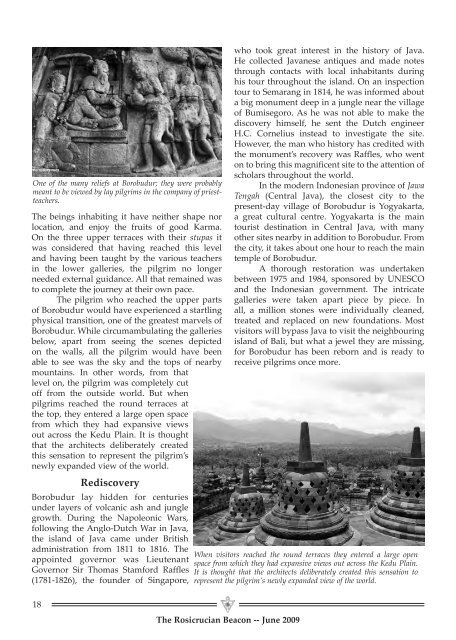RosicRucian - AMORC
RosicRucian - AMORC
RosicRucian - AMORC
- No tags were found...
Create successful ePaper yourself
Turn your PDF publications into a flip-book with our unique Google optimized e-Paper software.
One of the many reliefs at Borobudur; they were probablymeant to be viewed by lay pilgrims in the company of priestteachers.The beings inhabiting it have neither shape norlocation, and enjoy the fruits of good Karma.On the three upper terraces with their stupas itwas considered that having reached this leveland having been taught by the various teachersin the lower galleries, the pilgrim no longerneeded external guidance. All that remained wasto complete the journey at their own pace.The pilgrim who reached the upper partsof Borobudur would have experienced a startlingphysical transition, one of the greatest marvels ofBorobudur. While circumambulating the galleriesbelow, apart from seeing the scenes depictedon the walls, all the pilgrim would have beenable to see was the sky and the tops of nearbymountains. In other words, from thatlevel on, the pilgrim was completely cutoff from the outside world. But whenpilgrims reached the round terraces atthe top, they entered a large open spacefrom which they had expansive viewsout across the Kedu Plain. It is thoughtthat the architects deliberately createdthis sensation to represent the pilgrim’snewly expanded view of the world.RediscoveryBorobudur lay hidden for centuriesunder layers of volcanic ash and junglegrowth. During the Napoleonic Wars,following the Anglo-Dutch War in Java,the island of Java came under Britishadministration from 1811 to 1816. Theappointed governor was LieutenantGovernor Sir Thomas Stamford Raffles(1781-1826), the founder of Singapore,who took great interest in the history of Java.He collected Javanese antiques and made notesthrough contacts with local inhabitants duringhis tour throughout the island. On an inspectiontour to Semarang in 1814, he was informed abouta big monument deep in a jungle near the villageof Bumisegoro. As he was not able to make thediscovery himself, he sent the Dutch engineerH.C. Cornelius instead to investigate the site.However, the man who history has credited withthe monument’s recovery was Raffles, who wenton to bring this magnificent site to the attention ofscholars throughout the world.In the modern Indonesian province of JawaTengah (Central Java), the closest city to thepresent-day village of Borobudur is Yogyakarta,a great cultural centre. Yogyakarta is the maintourist destination in Central Java, with manyother sites nearby in addition to Borobudur. Fromthe city, it takes about one hour to reach the maintemple of Borobudur.A thorough restoration was undertakenbetween 1975 and 1984, sponsored by UNESCOand the Indonesian government. The intricategalleries were taken apart piece by piece. Inall, a million stones were individually cleaned,treated and replaced on new foundations. Mostvisitors will bypass Java to visit the neighbouringisland of Bali, but what a jewel they are missing,for Borobudur has been reborn and is ready toreceive pilgrims once more.When visitors reached the round terraces they entered a large openspace from which they had expansive views out across the Kedu Plain.It is thought that the architects deliberately created this sensation torepresent the pilgrim’s newly expanded view of the world.18The Rosicrucian Beacon -- June 2009











